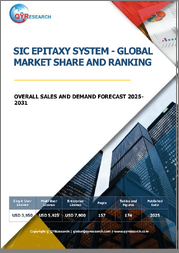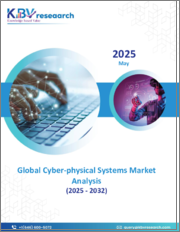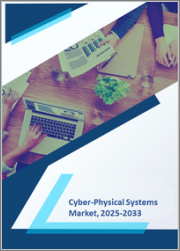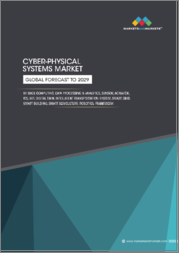
|
시장보고서
상품코드
1662879
세계의 사이버 물리 시스템(CPS) 시장(-2030년) : 컴포넌트별, 배포 형태별, 기술별, 용도별, 최종 사용자별, 지역별 예측 및 분석Cyber-Physical Systems (CPS) Market Forecasts to 2030 - Global Analysis By Component (Hardware, Software and Services), Deployment Mode (On-Premises, Cloud-Based and Hybrid), Technology, Application, End User and By Geography |
||||||
Stratistics MRC에 따르면 세계 CPS(Cyber Physical System) 시장은 2024년에 1,187억 달러를 달성하였고, 2030년에는 2,879억 달러에 이를 것으로 예측되며, 예측기간 동안 CAGR은 15.9%로 추정됩니다.
사이버 물리 시스템(CPS)은 인터넷이나 그 유저와 밀접하게 연결되고 컴퓨터 알고리즘에 의해 관리 및 관측되는 시스템입니다. 소프트웨어와 하드웨어가 복잡하게 얽힌 이러한 시스템은 다양한 시간적 및 공간적 규모로 작동하며 다양한 행동 방식을 보여줍니다. 사이버 물리 시스템은 센싱, 작동, 계산, 통신 기능을 결합하여 물리적 시스템의 전반적인 성능, 안전성, 신뢰성을 높입니다.
미국립표준기술실(NIST)에 따르면 차세대 사이버 물리 시스템(CPS)과 사물인터넷(IoT)을 교통, 에너지, 건강 등의 부문에 적용함으로써 미국의 생산성 성장을 1.5%나 높일 수 있다고 합니다.
IoT 채용 확대
사물인터넷(IoT)의 통합은 시장 성장의 중요한 촉진요인입니다. IoT는 실시간 데이터 수집, 분석 및 의사 결정을 가능하게 함으로써 CPS의 기능을 향상시킵니다. 이러한 연결성은 제조, 의료, 운송 등 산업 전체의 업무 효율성을 향상시킵니다. 스마트 공장과 인더스트리 4.0 개념의 상승은 예측 유지보수, 자원 최적화 및 자동화를 위해 IoT 기반 CPS에 대한 수요를 더욱 증가시키고 있습니다. IoT와 CPS의 이러한 공생 관계는 혁신과 채택을 크게 가속화합니다.
높은 도입 비용
CPS 솔루션의 도입에는 높은 초기 비용이 발생하기 때문에 특히 중소기업(SME)에서의 보급이 지장을 받고 있습니다. 이러한 시스템은 첨단 인프라, 최첨단 기술 및 숙련된 인력을 필요로 하므로 경제적 부담이 커집니다. 게다가 CPS와 기존 시스템의 통합이 복잡하기 때문에 도입 비용이 많이 들고 투자 회수가 지연됩니다. 많은 기업들에게 이러한 경제적 장벽은 장기적인 이점을 능가하므로 시장 침투를 늦추고 성장 기회를 제한합니다.
스마트 제조에 대한 수요 증가
세계적인 스마트 제조 추세는 CPS에 큰 기회를 제공합니다. 이러한 시스템은 실시간 모니터링, 예측 유지보수, 적응적인 생산 공정을 가능하게 하고 효율성을 높이며 다운타임을 줄입니다. 인더스트리 4.0에서는 IoT, AI, 로보틱스를 활용하여 최적화된 운영을 실현하는 스마트 공장을 구축하기 위해 CPS 통합을 우선시합니다. 제조업이 생산성과 지속 가능성 향상을 목표로 하면서 자동차, 일렉트로닉스, 에너지 등의 부문에서의 CPS 수요는 크게 증가할 것으로 예상됩니다.
보안 우려
CPS는 상호 연결되어 있기 때문에 사이버 위협에 취약합니다. 보안 침해는 업무를 중단시키고 기밀 데이터를 유출하여 경제적 손실과 안전 위험을 초래할 수 있습니다. 많은 CPS 내 견고한 사이버 보안 조치의 부재는 이러한 위협을 악화시키고 있습니다. 사이버 공격이 더욱 정교해짐에 따라 조직은 시스템을 보호하기 위해 보안 솔루션에 상당한 투자를 해야 하며 이는 운영 비용을 증가시키거나 배포를 지연시킬 수 있습니다.
COVID-19의 영향
COVID-19의 대유행은 규제 가운데 업무를 유지하기 위해 산업에서 자동화를 요구하면서 CPS의 채용을 가속화했습니다. 의료 등의 부문에서는 원격 모니터링이나 진단에 CPS가 이용되고, 제조업에서는 인적 개입을 최소한으로 억제하여 효율성을 확보하기 위해 CPS가 채용되었습니다. 그러나 공급망의 혼란으로 인해 부품의 입수와 설치가 지연되었습니다. 팬데믹은 급격히 도입된 시스템의 사이버 보안 취약성도 노출시켰습니다. 이러한 과제에도 불구하고 팬데믹 위기는 업무의 연속성을 확보하기 위해 CPS와 같은 탄력성 있는 기술의 중요성을 부각시켰습니다.
예측기간 동안 산업 자동화 부문이 최대로 성장할 전망
산업 자동화 부문은 제조산업 및 에너지와 같은 부문에서 생산공정을 최적화하는 데 중요한 역할을 하기 때문에 예측기간 동안 최대 시장 점유율을 차지할 것으로 예상됩니다. CPS는 실시간 모니터링, 예측 유지보수 및 적응 제어 메커니즘을 가능하게 함으로써 자동화를 강화합니다. 이러한 기능은 다운타임을 줄이고 자원 활용도를 높여 일관된 제품 품질을 보장합니다. 또한 인더스트리 4.0의 채용이 확대되고 있는 것도 산업 자동화를 촉진하여 CPS 채용의 중요한 추진력이 되고 있습니다.
예측기간 동안 클라우드 기반 부문의 CAGR이 가장 높을 것으로 예상
예측기간 동안 클라우드 기반 부문은 확장성, 비용효율성 및 접근 용이성으로 인해 가장 높은 성장률을 나타낼 것으로 예상됩니다. 클라우드 플랫폼은 CPS와 IoT 디바이스의 원활한 통합을 가능하게 하고 실시간 데이터 처리 및 분석을 실현합니다. 이러한 모델은 온프레미스 솔루션에 비해 인프라 비용을 절감하면서 원격 모니터링 및 관리를 지원합니다. 산업이 디지털 변환 전략을 채택함에 따라 클라우드 기반 CPS 솔루션은 큰 성장을 이룰 것으로 예상됩니다.
최대 점유율을 차지하는 지역
예측기간 동안 아시아태평양은 급속한 산업화와 중국, 일본, 인도 등의 국가의 스마트 인프라 프로젝트에 대한 대규모 투자로 최대 시장 점유율을 차지할 것으로 예상됩니다. 이 지역에서는 인더스트리 4.0가 중시되고 있으며, 제조, 에너지 관리, 운송의 각 부문에서 CPS 수요가 높아지고 있습니다. 디지털 전환을 지원하는 정부 프로그램은 이 지역의 시장 성장을 더욱 강화하고 있습니다.
CAGR이 가장 높은 지역
예측기간 동안 아시아태평양은 자동차, 에너지 등 주요 부문에서 IoT, AI 등의 선진기술의 견고한 채용 추세로 인해 CAGR이 가장 높을 것으로 예측됩니다. 스마트 시티 프로젝트와 신재생에너지에 대한 노력은 이 지역에서 CPS 개발의 추가 기회를 창출하고 있습니다. 자동화에 중점을 두는 경향이 커지면서 예측기간 내내 지속적인 성장이 예상됩니다.
무료 맞춤형 서비스
본 보고서를 구독하시는 고객께는 다음 무료 맞춤 옵션 중 하나가 제공됩니다.
- 기업 프로파일
- 추가 시장 진출기업의 종합적 프로파일링(최대 3개사)
- 주요 기업의 SWOT 분석(최대 3개사)
- 지역 세분화
- 고객의 관심에 맞춘 주요국 시장 추정, 예측 및 CAGR(주 : 실현가능성에 따름)
- 경쟁 벤치마킹
- 제품 포트폴리오, 지리적 존재, 전략적 제휴를 통한 주요 기업 벤치마킹
목차
제1장 주요 요약
제2장 서문
- 개요
- 이해관계자
- 조사 범위
- 조사 방법
- 데이터 마이닝
- 데이터 분석
- 데이터 검증
- 조사 접근
- 조사 정보원
- 1차 조사 정보원
- 2차 조사 정보원
- 전제조건
제3장 시장 동향 분석
- 소개
- 성장 촉진요인
- 억제요인
- 기회
- 위협
- 기술 분석
- 용도 분석
- 최종 사용자 분석
- 신흥 시장
- COVID-19의 영향
제4장 Porter's Five Forces 분석
- 공급기업의 협상력
- 구매자의 협상력
- 대체품의 위협
- 신규 참가업체의 위협
- 경쟁 기업간 경쟁 관계
제5장 세계의 사이버 물리 시스템(CPS) 시장 : 컴포넌트별
- 소개
- 하드웨어
- 센서 및 액추에이터
- 임베디드 시스템
- 통신 하드웨어
- 소프트웨어
- 제어 시스템 소프트웨어
- 데이터 관리 및 분석 소프트웨어
- 통신 프로토콜/미들웨어
- 사이버 보안 소프트웨어
- 서비스
- 시스템 통합
- 컨설팅 서비스
- 유지보수 및 지원
제6장 세계의 사이버 물리 시스템(CPS) 시장 : 배포 형태별
- 소개
- 온프레미스
- 클라우드 기반
- 하이브리드
제7장 세계의 사이버 물리 시스템(CPS) 시장 : 기술별
- 소개
- 엣지 컴퓨팅
- 산업용 제어 시스템(ICS)/SCADA
- 디지털 트윈
- 블록체인
- 인공지능(AI)/머신러닝(ML)
제8장 세계의 사이버 물리 시스템(CPS) 시장 : 용도별
- 소개
- 산업 자동화
- 스마트 인프라
- 커넥티드 헬스케어
- 방위 및 안보
- 스마트 농업
- 스마트 홈/소비자 용도
- 기타
제9장 세계의 사이버 물리 시스템(CPS) 시장 : 최종 사용자별
- 소개
- 제조업
- 자동차
- 에너지 및 유틸리티
- 정부 및 공공부문
- 운송 및 물류
- 의료
- IT 및 통신
- 항공우주 및 방위
- 농업
- 소매
제10장 세계의 사이버 물리 시스템(CPS) 시장 : 지역별
- 소개
- 북미
- 미국
- 캐나다
- 멕시코
- 유럽
- 독일
- 영국
- 이탈리아
- 프랑스
- 스페인
- 기타 유럽
- 아시아태평양
- 일본
- 중국
- 인도
- 호주
- 뉴질랜드
- 한국
- 기타 아시아태평양
- 남미
- 아르헨티나
- 브라질
- 칠레
- 기타 남미
- 중동 및 아프리카
- 사우디아라비아
- 아랍에미리트(UAE)
- 카타르
- 남아프리카
- 기타 중동 및 아프리카
제11장 주요 개발
- 계약/파트너십/협업/합작투자(JV)
- 인수 및 합병
- 신제품 발매
- 사업 확대
- 기타 주요 전략
제12장 기업 프로파일링
- ABB
- Honeywell International Inc.
- Hitachi Ltd.
- Schneider Electric
- Siemens
- Rockwell Automation
- Continental AG
- General Electric Company
- Toshiba Corporation
- Robert Bosch GmbH
- Cisco Systems Inc.
- Emerson Electric Co.
- Intel Corporation
- IBM Corporation
- Dassault Systemes
- Microsoft
- SAP SE
- Mitsubishi Electric Corporation
According to Stratistics MRC, the Global Cyber-Physical Systems (CPS) Market is accounted for $118.7 billion in 2024 and is expected to reach $287.9 billion by 2030 growing at a CAGR of 15.9% during the forecast period. Cyber-Physical Systems (CPS) are systems that are closely linked to the internet and its users and are managed and observed by computer algorithms. Software and hardware are intricately entwined in these systems, which function on various temporal and spatial scales and display a variety of behavioral modalities. They enhance the overall performance, safety, and dependability of physical systems by combining sensing, actuation, computation, and communication capabilities.
According to the National Institute of Standards and Technology (NIST), the deployment of next-generation Cyber-Physical Systems (CPS) and the Internet of Things (IoT) across sectors such as transportation, energy, and health could boost U.S. productivity growth by as much as 1.5%.
Market Dynamics:
Driver:
Growing adoption of IoT
The integration of the Internet of Things (IoT) is a key driver for market growth. IoT enhances CPS capabilities by enabling real-time data collection, analysis, and decision-making. This connectivity improves operational efficiency across industries like manufacturing, healthcare, and transportation. The rise of smart factories and Industry 4.0 initiatives further amplifies the demand for IoT-enabled CPS, as they enable predictive maintenance, resource optimization, and automation. This symbiotic relationship between IoT and CPS significantly accelerates innovation and adoption.
Restraint:
High implementation costs
The high initial costs of deploying CPS solutions hinder their widespread adoption, especially among small and medium-sized enterprises (SMEs). These systems require advanced infrastructure, cutting-edge technologies, and skilled personnel, which can be financially burdensome. Additionally, the complexity of integrating CPS with existing systems increases installation expenses and delays return on investment. For many organizations, these financial barriers outweigh the long-term benefits, slowing down market penetration and limiting growth opportunities.
Opportunity:
Rising demand for smart manufacturing
The global shift towards smart manufacturing presents significant opportunities for CPS. These systems enable real-time monitoring, predictive maintenance, and adaptive production processes, enhancing efficiency and reducing downtime. Industry 4.0 initiatives prioritize CPS integration to create smart factories that leverage IoT, AI, and robotics for optimized operations. As manufacturers seek to improve productivity and sustainability, the demand for CPS in sectors like automotive, electronics, and energy is expected to rise substantially.
Threat:
Security concerns
CPS are vulnerable to cyber threats due to their interconnected nature. Security breaches can disrupt operations, compromise sensitive data, and result in financial losses or safety risks. The lack of robust cybersecurity measures in many CPS deployments exacerbates this threat. As cyberattacks become more sophisticated, organizations must invest heavily in security solutions to protect their systems, which can increase operational costs and deter adoption.
Covid-19 Impact:
The COVID-19 pandemic accelerated the adoption of CPS as industries sought automation to maintain operations amidst restrictions. Sectors like healthcare relied on CPS for remote monitoring and diagnostics, while manufacturing adopted these systems to ensure efficiency with minimal human intervention. However, supply chain disruptions delayed component availability and installations. The pandemic also exposed cybersecurity vulnerabilities in hastily deployed systems. Despite these challenges, the crisis underscored the importance of resilient technologies like CPS in ensuring operational continuity.
The industrial automation segment is expected to be the largest during the forecast period
The industrial automation segment is expected to account for the largest market share during the forecast period due to its critical role in optimizing production processes across sectors like manufacturing and energy. CPS enhances automation by enabling real-time monitoring, predictive maintenance, and adaptive control mechanisms. These capabilities reduce downtime, improve resource utilization, and ensure consistent product quality. Additionally, the growing adoption of Industry 4.0 practices further solidifies industrial automation as a key driver for CPS adoption.
The cloud-based segment is expected to have the highest CAGR during the forecast period
Over the forecast period, the cloud-based segment is predicted to witness the highest growth rate due to its scalability, cost-effectiveness, and ease of access. Cloud platforms enable seamless integration of CPS with IoT devices for real-time data processing and analytics. This model supports remote monitoring and management while reducing infrastructure costs compared to on-premises solutions. As industries increasingly adopt digital transformation strategies, cloud-based CPS solutions are set to witness significant growth.
Region with largest share:
During the forecast period, the Asia Pacific region is expected to hold the largest market share due to rapid industrialization and extensive investments in smart infrastructure projects across countries like China, Japan, and India. The region's focus on Industry 4.0 initiatives drives demand for CPS in manufacturing, energy management, and transportation sectors. Government programs supporting digital transformation further bolster market growth in this region.
Region with highest CAGR:
Over the forecast period, the Asia Pacific region is anticipated to exhibit the highest CAGR due to its robust adoption of advanced technologies like IoT and AI in key sectors such as automotive and energy. Smart city projects and renewable energy initiatives create additional opportunities for CPS deployment in this region. The increasing emphasis on automation ensures sustained growth throughout the forecast period.
Key players in the market
Some of the key players in Cyber-Physical Systems (CPS) Market include ABB, Honeywell International Inc., Hitachi Ltd., Schneider Electric, Siemens, Rockwell Automation, Continental AG, General Electric Company, Toshiba Corporation, Robert Bosch GmbH, Cisco Systems Inc., Emerson Electric Co., Intel Corporation, IBM Corporation, Dassault Systemes, Microsoft, SAP SE and Mitsubishi Electric Corporation.
Key Developments:
In January 2025, Siemens has installed and commissioned the world's first 8DAB 24, the groundbreaking blue GIS medium-voltage system, in the Alpine town of Davos, Switzerland for its customer EWD Elektrizitatswerk Davos AG. The switchgear system, which uses Clean Air as insulating gas instead of sulfur hexafluoride (SF6), is deployed in the Dorf substation in Davos, securing reliable power supply for up to 40,000 people. The installation of this 24kV circuit-breaker switchgear is an important step towards a climate-friendly and smart power distribution in Davos.
In September 2022, ABB has launched ABB Ability Cyber Security Workplace (CSWP) which enhances the protection of critical industrial infrastructure by consolidating both ABB and third-party security solutions into one simple, all-encompassing digital platform. By making cyber security information more accessible and easier to manage, engineers and operators can quickly identify and remediate issues, reducing exposure to risk.
Components Covered:
- Hardware
- Software
- Services
Deployment Modes Covered:
- On-Premises
- Cloud-Based
- Hybrid
Technologies Covered:
- Edge Computing
- Industrial Control Systems (ICS)/SCADA
- Digital Twin
- Blockchain
- Artificial Intelligence (AI)/Machine Learning (ML)
Applications Covered:
- Industrial Automation
- Smart Infrastructure
- Connected Healthcare
- Defense and Security
- Smart Agriculture
- Smart Home/Consumer Applications
- Other Applications
End Users Covered:
- Manufacturing
- Automotive
- Energy and Utilities
- Government and Public Sector
- Transportation and Logistics
- Healthcare
- IT and Telecommunications
- Aerospace and Defense
- Agriculture
- Retail
Regions Covered:
- North America
- US
- Canada
- Mexico
- Europe
- Germany
- UK
- Italy
- France
- Spain
- Rest of Europe
- Asia Pacific
- Japan
- China
- India
- Australia
- New Zealand
- South Korea
- Rest of Asia Pacific
- South America
- Argentina
- Brazil
- Chile
- Rest of South America
- Middle East & Africa
- Saudi Arabia
- UAE
- Qatar
- South Africa
- Rest of Middle East & Africa
What our report offers:
- Market share assessments for the regional and country-level segments
- Strategic recommendations for the new entrants
- Covers Market data for the years 2022, 2023, 2024, 2026, and 2030
- Market Trends (Drivers, Constraints, Opportunities, Threats, Challenges, Investment Opportunities, and recommendations)
- Strategic recommendations in key business segments based on the market estimations
- Competitive landscaping mapping the key common trends
- Company profiling with detailed strategies, financials, and recent developments
- Supply chain trends mapping the latest technological advancements
Free Customization Offerings:
All the customers of this report will be entitled to receive one of the following free customization options:
- Company Profiling
- Comprehensive profiling of additional market players (up to 3)
- SWOT Analysis of key players (up to 3)
- Regional Segmentation
- Market estimations, Forecasts and CAGR of any prominent country as per the client's interest (Note: Depends on feasibility check)
- Competitive Benchmarking
- Benchmarking of key players based on product portfolio, geographical presence, and strategic alliances
Table of Contents
1 Executive Summary
2 Preface
- 2.1 Abstract
- 2.2 Stake Holders
- 2.3 Research Scope
- 2.4 Research Methodology
- 2.4.1 Data Mining
- 2.4.2 Data Analysis
- 2.4.3 Data Validation
- 2.4.4 Research Approach
- 2.5 Research Sources
- 2.5.1 Primary Research Sources
- 2.5.2 Secondary Research Sources
- 2.5.3 Assumptions
3 Market Trend Analysis
- 3.1 Introduction
- 3.2 Drivers
- 3.3 Restraints
- 3.4 Opportunities
- 3.5 Threats
- 3.6 Technology Analysis
- 3.7 Application Analysis
- 3.8 End User Analysis
- 3.9 Emerging Markets
- 3.10 Impact of Covid-19
4 Porters Five Force Analysis
- 4.1 Bargaining power of suppliers
- 4.2 Bargaining power of buyers
- 4.3 Threat of substitutes
- 4.4 Threat of new entrants
- 4.5 Competitive rivalry
5 Global Cyber-Physical Systems (CPS) Market, By Component
- 5.1 Introduction
- 5.2 Hardware
- 5.2.1 Sensors and Actuators
- 5.2.2 Embedded Systems
- 5.2.3 Communication Hardware
- 5.3 Software
- 5.3.1 Control Systems Software
- 5.3.2 Data Management and Analytics Software
- 5.3.3 Communication Protocols/Middleware
- 5.3.4 Cybersecurity Software
- 5.4 Services
- 5.4.1 System Integration
- 5.4.2 Consulting Services
- 5.4.3 Maintenance and Support
6 Global Cyber-Physical Systems (CPS) Market, By Deployment Mode
- 6.1 Introduction
- 6.2 On-Premises
- 6.3 Cloud-Based
- 6.4 Hybrid
7 Global Cyber-Physical Systems (CPS) Market, By Technology
- 7.1 Introduction
- 7.2 Edge Computing
- 7.3 Industrial Control Systems (ICS)/SCADA
- 7.4 Digital Twin
- 7.5 Blockchain
- 7.6 Artificial Intelligence (AI)/Machine Learning (ML)
8 Global Cyber-Physical Systems (CPS) Market, By Application
- 8.1 Introduction
- 8.2 Industrial Automation
- 8.3 Smart Infrastructure
- 8.4 Connected Healthcare
- 8.5 Defense and Security
- 8.6 Smart Agriculture
- 8.7 Smart Home/Consumer Applications
- 8.8 Other Applications
9 Global Cyber-Physical Systems (CPS) Market, By End User
- 9.1 Introduction
- 9.2 Manufacturing
- 9.3 Automotive
- 9.4 Energy and Utilities
- 9.5 Government and Public Sector
- 9.6 Transportation and Logistics
- 9.7 Healthcare
- 9.8 IT and Telecommunications
- 9.9 Aerospace and Defense
- 9.10 Agriculture
- 9.11 Retail
10 Global Cyber-Physical Systems (CPS) Market, By Geography
- 10.1 Introduction
- 10.2 North America
- 10.2.1 US
- 10.2.2 Canada
- 10.2.3 Mexico
- 10.3 Europe
- 10.3.1 Germany
- 10.3.2 UK
- 10.3.3 Italy
- 10.3.4 France
- 10.3.5 Spain
- 10.3.6 Rest of Europe
- 10.4 Asia Pacific
- 10.4.1 Japan
- 10.4.2 China
- 10.4.3 India
- 10.4.4 Australia
- 10.4.5 New Zealand
- 10.4.6 South Korea
- 10.4.7 Rest of Asia Pacific
- 10.5 South America
- 10.5.1 Argentina
- 10.5.2 Brazil
- 10.5.3 Chile
- 10.5.4 Rest of South America
- 10.6 Middle East & Africa
- 10.6.1 Saudi Arabia
- 10.6.2 UAE
- 10.6.3 Qatar
- 10.6.4 South Africa
- 10.6.5 Rest of Middle East & Africa
11 Key Developments
- 11.1 Agreements, Partnerships, Collaborations and Joint Ventures
- 11.2 Acquisitions & Mergers
- 11.3 New Product Launch
- 11.4 Expansions
- 11.5 Other Key Strategies
12 Company Profiling
- 12.1 ABB
- 12.2 Honeywell International Inc.
- 12.3 Hitachi Ltd.
- 12.4 Schneider Electric
- 12.5 Siemens
- 12.6 Rockwell Automation
- 12.7 Continental AG
- 12.8 General Electric Company
- 12.9 Toshiba Corporation
- 12.10 Robert Bosch GmbH
- 12.11 Cisco Systems Inc.
- 12.12 Emerson Electric Co.
- 12.13 Intel Corporation
- 12.14 IBM Corporation
- 12.15 Dassault Systemes
- 12.16 Microsoft
- 12.17 SAP SE
- 12.18 Mitsubishi Electric Corporation



















